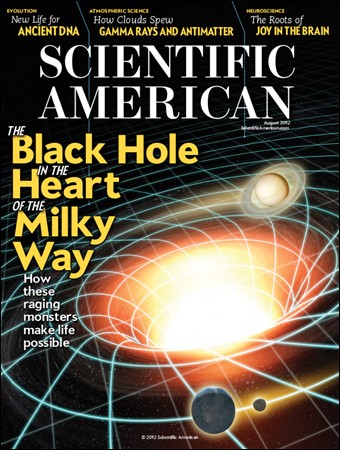The Goldilocks Planet
Or..Did the Universe Know We Were Coming?
By Neil Earle

Scientific American has done it again.
Back in 1981 a provocative concept emerged in this well-known publication. A generation back Scientific American introduced its audiences to the concept of the Anthropic Principle. The word is derived from the Greek for “man” (anthropos) and conveys the idea that “the Universe knew we were coming,” that too many features are “just right” for human life to have simply been a cosmic accident.
Now in the August, 2012 Scientific American comes the headline “The Black Hole in the Heart of the Milky Way: How these raging monsters make life possible.” Dr. Caleb Scharf, an astrophysicist at Columbia University, once again touches on the Anthropic idea. Scharf’s actual inside title was “The Benevolence of Black Holes” and he raised the humorous (and anthropically related) maxim called “the Humphrey Bogart effect” – of all the places in all the galaxies in all the universe, we found ourselves in the one best suited for human life to thrive.
This is the Anthropic Principle writ large and Scharf is aware of it. The fact that Black Holes – some of them he claims 100 billion times the size of our sun!!! – are like gigantic spinning electrical batteries expelling matter at light speed across the universe. This not only makes life possible but raises a captivating subject for believers and non-believers both. “Black holes are not just consumers,” says Scharf, “they also radiate copious amounts of energy back into the universe.” That includes the all-important element of carbon. Sir John Polkinghorne, a quark researcher turned Anglican priest, has been showing for years that the carbon 12 atoms in our universe and in our bodies has been the major ingredient for life and that they are produced in one place only – the immense nuclear furnaces of the stars from where they are sprayed across the cosmos.
In that he agrees with a science popularizer of a generation back, Carl Sagan, who referred to us humans as “animated stardust.”
The Third Rock
The Anthropic Principle is a little easier to grasp when we focus on known and observable facts about out own planet, Earth – the third rock from the sun. Even the word “rock” is important here because it is the earth’s iron and mineral core that generates the magnetic field that shields us from harmful radiation and debris coming from space. We also get the spectacular Northern Lights thrown in as an extra bonus. But let’s begin at the beginning of the Goldilocks story – the relationship of the earth to our sun system.
Consider: if the earth were too close to the sun we could end up like Mercury – a scarred, fiery pizza-looking planet. Too far away and the earth could be much colder but even more important, lose its stable water cycle, the plant-moisture dynamic that makes photosynthesis possible. “Photosynthesis” – the one big word we probably remember from Eight Grade science encompassing the process that makes plant life possible. Even if the sun were redder or bluer there would be death-dealing affects here below. Scientific theologian John Polkinghorne’s word for all this is “fine-tuning” and what a great concept it is.
But there is much much more. Let’s consider “the moon and stars which God has ordained” (Psalm 8:3 AV). For life on earth to thrive, our moon is in just the right position. If it were closer its gravitational pull would mean that great tides would sweep the earth – Manhattan Island would be under water and many other places besides. If the moon were further away its gravitational affect on earth would be weaker and the rotation of the underwater channels and streams such as the Gulf Stream would be slowed. This would affect plankton and other vital necessities for life on the land and sea. Again, we are on a Goldliocks Planet – neither too far nor too close.
Isaiah advised believers to lift their eyes to the heavens (Isaiah 40:26), so let’s do that for a second. Let’s consider the Van Allen Belt linked to the earth’s magnetic fields. In recent years we have heard much about the atmosphere’s Ozone Layer being damaged (but slowly repairing) and we know what excessive ultraviolet light can mean for human prospects. But…the Van Allen Belt shields us from harmful radiation from the sun as part of the Earth’s Electromagnetic Field which protectively swathes the earth and strains out meteor and other cosmic debris that would greatly hinder the development of life on this earth. Says the science writer John Gribbin: “So another reason we are here is that the Earth has a strong magnetic field, and the reason it has a strong magnetic field is that it has a large metallic core” (The Reason Why, page 138).
Which came first, the core or the shield? The magnetosphere is tied to the iron and other hard elements in the earth’s crust and makes i-phones and text messages possible – not to mention television. This is one reason both Carl Sagan and Albert Einstein grooved over the magnetic fields discoverer, that devout Scottish Christian James Clerk Maxwell (1864) whose name even appears occasionally on the popular TV show “The Big Bang Theory.” Gribbin adds that when the magnetic fields reverse – which it apparently has done on several occasions – then any life forms are quickly rendered extinct, a possible explanation for the dinosaur’s passing.
The metallic core or the magnetosphere? Which came first? Goldilocks Planet theorists have the luxury to ponder this intriguing question.
Cooking Carbon
We could go on all day about anthropic fine-tuning BUT…we saved one of the best till last. Perhaps the most surprising and least publicized curiosity relating to human life is touched on by Dr. Scharf in his article. This is the idea that that the creation of huge amounts of carbon in the Black Holes matches with the previously mentioned idea that life is made possible on earth because of Carbon 12 being produced in the stars. Black Holes are basically enormous star systems that have burned themselves out and gravity causes them to collapse upon themselves.

John Polkinghorne (pictured, left), author of Belief in God in an Age of Science, covers this often with his audiences. Polkinghorne is a former subatomic specialist turned Anglican minister. He often makes the particular point that the dynamic timing and intricate systems necessary to “cook” carbon to just the right specifications for human life is found in the interior of the distant stars. He shows how his colleague, astronomer Fred Hoyle, a convinced atheist, was taken aback at the fact that this carbon production emerges at exactly the right levels (“resonances”) to make human life possible. (Our bodies are mostly carbon).
Faced with this anomaly, Hoyle blurted out in his best British scientific shorthand that “the Universe is a put-up job.” Hoyle admitted that some “capital I Intelligence” must have been “monkeying with the laws of nature.” Polkinghorne cites this as a dramatic example of fine-tuning, and references Hebrews 11:3, “For since the creation of the world, God’s invisible qualities – his eternal power and divine nature – have been clearly seen, being understood from what has been made…”
Wonderful stuff.
Covering the Bases
Of course these conclusions have been contested by other equally reputable researchers but…the point here is that both believers and non-believers should be aware of such debates within the scientific community. Too often eager and “breathless” claims (the British journalistic phrase) get noised in the Science page of a major or minor newspaper and the Science/Religion bun fight is on again. Too bad,
Now, if the Anthropic Principle smacks of a replay of the somewhat discredited “argument from Design,” then hold on! The noted scientific theologian Tom Torrance (died 2007) criticized the Design Argument as being somewhat ambiguous because of the double-edged nature of cosmic reality.

What did he mean? Well there are the precise measurements of the clockwork regularity about the orbiting planets and the likes, says Torrance (pictured, left), that much we know from Newton and his disciples. His equations helped get us to the moon. But, adda Torrance, there are also plenty of adverse side effects flying around. The heavenly bodies are wonderful to look at but – consider – there are immense solar storms and flares that break out on the sun and make space exploration sometimes hazardous. Asteroids and meteors and the Berringer Crater in Arizona are blunt reminders that the Cosmos is not a complete safety-free zone. In St. Paul’s apt phrase, “frustration” undermines the near orderly perfection of things (Romans 8:21).
So we see the beauty of the Hoodoos, the California redwoods but also Hurricane Katrina, the Midwest drought and the Northridge Earthquake. There are happy accidents such as seen in the discovery of penicillin and there are devastating perfect storms and floods.
Torrance explains all this as a factor of God’s conferring a dynamic freedom on the Universe. The cosmos is both turned towards order and disorder at the same time, he says. Stuff happens. Thus, “the universe is characterized by neither uncertainly nor necessity. Far from being closed or predetermined, the universe constitutes an open-textured system in which novel forms of order constantly emerge.”
In spite of asteroids roaring in at us from space and supernovas exploding in deep space with displays of monstrous power, the system works well enough for life to thrive on our Goldilocks Planet. In all the Universe, so far, this is the place to be. As Polkinghorne says the Universe is indeed “shot through with signs of Mind.” Believers in God have always seen the end result of things on this planet as evidence for God’s sustaining hand. “By Him all things exist and in Him all things hold together” (Colossians 1:17). Well said. Let’s be thankful for the life God has given us as part of our Goldilocks Planet.